The Florida residential market is the third-largest market in the United States at the state level, as it houses a population of 21,477,737, according to July 2019 estimates. Over the period 2010-2019, Florida’s population registered the second-largest increase in terms of headcount and the fifth-highest increase in percentage terms among all 50 states.
Florida is a great place to live. It has a great climate with more than 200 sunny and warm days a year. It has hundreds of miles of sandy beaches including some of the world’s best and most beautiful, such as Sarasota’s Siesta Public Beach, Clearwater Beach, Pensacola Beach, Delray Beach, St. Joseph Peninsula, etc. It has also more than 1,300 golf courses, many recreational activities, and world-class theme parks such as Disneyland and Epcot Center in Orlando that attract millions of visitors from all over the globe.
Florida has an extensive and high-quality educational system that has been rated among the top ten in the U.S. by U.S. News & World Report. It has also great cultural diversity and a rich and exciting sports scene with three NFL teams (Jacksonville Jaguars, Miami Dolphins, Tampa Bay Buccaneers) two NBA teams (Miami Heat and Orlando Magic), two MLB teams (Miami Marlins, Tampa Bay Rays) and two NHL teams (Florida Panthers and Tampa Bay Lighting).
A key economic benefit from living in Florida is higher disposable income because there is no state income tax.
When it comes to residential investments Florida is second to none because it is endowed with a unique combination of investment advantages that cannot be found in any other state. In particular, Florida’s residential market combines the following investment benefits:
- It combines the fifth highest capital gains with the greatest number of large metropolitan housing markets among the top five states in terms of house price growth
- It combines the strength, diversity, and resilience of the fourth largest state economy with the fastest job growth rate in the country
- It combines fast population growth with fast income growth that fuel a robust and fast-rising housing demand
- It combines competitive income returns with strong capital gains that can allow investors to achieve double-digit returns
- It combines exceptional liquidity and easy investment entry and exit with a multiplicity of investment opportunities across a wide spectrum of prices and locations
The Florida residential market combines high capital gains with the greatest number of large metropolitan housing markets to invest in
According to the FHFA House Price Index, house prices in Florida registered a cumulative capital gain of 90% over the period 2010-2020. This was the fifth highest percentage increase among all states (see Figure 1). These high capital gains combined with the fact that Florida is by far the largest among these five states make Florida’s residential market a unique investment choice across all U.S. states.
Figure 1 Top five states in terms of house price increases over the period 2010-2020
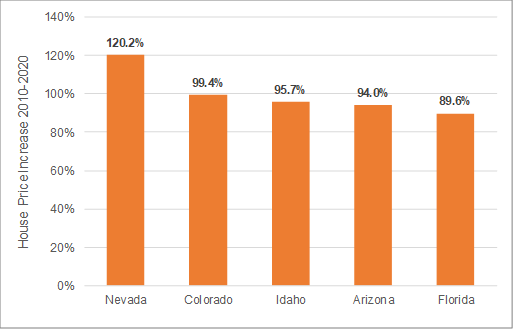
As it can be seen from Figure 2, the Florida residential market is at least three times larger than any of the other four states that have registered somewhat higher cumulative house price growth over the period 2010-20.
This is an important difference for real estate investors because it means that they have the choice of investing in a considerably greater number of large metropolitan housing markets in Florida. This is a key investment advantage because large metropolitan housing markets provide very high liquidity and easy investment entry and exit.
This point is underscored by the fact that Florida has seven metropolitan areas among the 81 largest metropolitan areas in the United States, with populations ranging from 724,777 (Lakeland-Winter Haven metropolitan area) to 6,166,488 (Miami-Fort Lauderdale-West Palm Beach metropolitan area). The other four states have at maximum only two metropolitan housing markets (Arizona and Colorado) that are included in the 81 largest metropolitan areas in the U.S.
Figure 2 2019 population in the five states with the fastest growth in house prices over the period 2010-2020

Florida combines the strength, diversity and resilience of the fourth largest state economy in the country with the fastest job growth rate
Florida’s residential market is backed by the fourth largest state economy in the U.S. In particular, in 2019 Florida had the fourth largest real GDP, total employment, and non-farm employment, with California, Texas, and New York being the three largest in terms of these three indicators. In 2019, total employment in Florida was 12,857,048.
Florida’s economy is quite diverse with 77% of its total non-farm employment distributed to five sectors, and particularly Trade, Transportation, and Utilities, Professional and Business Services, Education and Health Services, Government, and Leisure and Hospitality (see Figure 3). The contribution of these sectors to Florida’s total non-farm employment ranges from 12.5% (Leisure and Hospitality) to 20.6% (Trade, Transportation, and Utilities). This diversity makes Florida’s economy less vulnerable to industry-specific economic shocks and reduces the long-term risk of investments in the state’s residential market.
The long-term risk of investments in the Florida residential market is also reduced by the very strong long-term rate by which the state’s economy produces new jobs. This reduces residential investment risk because it supports strong population growth and rising housing demand in the long term. As Figure 4 shows, the Florida economy produced new jobs at the fastest rate among all states over the period 2010-2020, during which the state’s total employment increased by 30.6%.
Figure 3 Florida non-farm employment composition by economic sector in November 2020

Figure 4 Ten Top States in Terms of Job Growth Over the Period 2010-2020
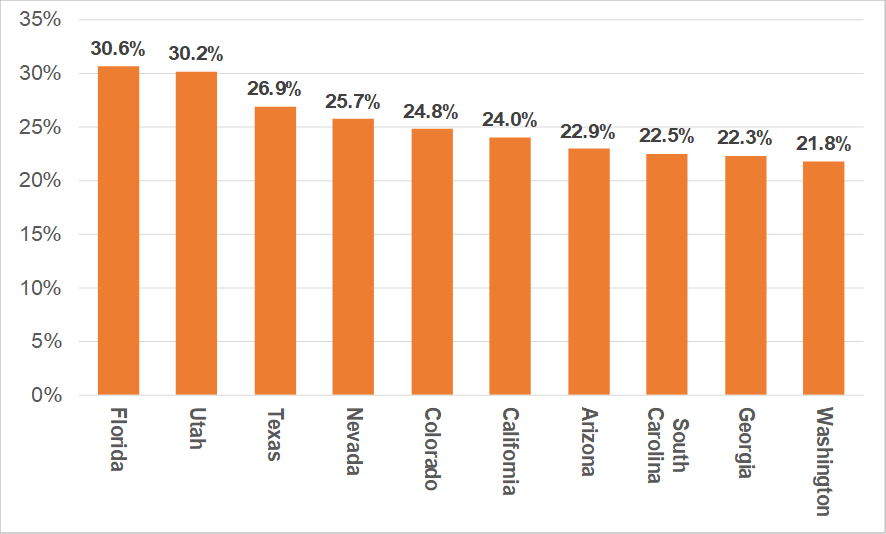
The Florida residential market is supported by a fast population and income growth that fuel a robust and rising housing demand
Over the period 2010-2019 Florida’s population increased by 2,673,173 people, representing the second-largest increase in terms of headcount and the fifth-largest increase in percentage terms among all 50 states. In particular, the state’s population increased by 14.2%, which is more than twice faster than the average state population growth rate of 5.9% over that period.
The median age of the area’s population was 42.4 years in 2019, with 43.6% being in the age group of 20-54, which comprises the households that are most active in the housing market by renting a house, buying their first home, or upgrading to a better house (see Figure 5). In terms of racial composition, 74.5% of Florida’s population are White, 16% Black, and 2.8% Asian.
Figure 5 Florida population by age group in 2019
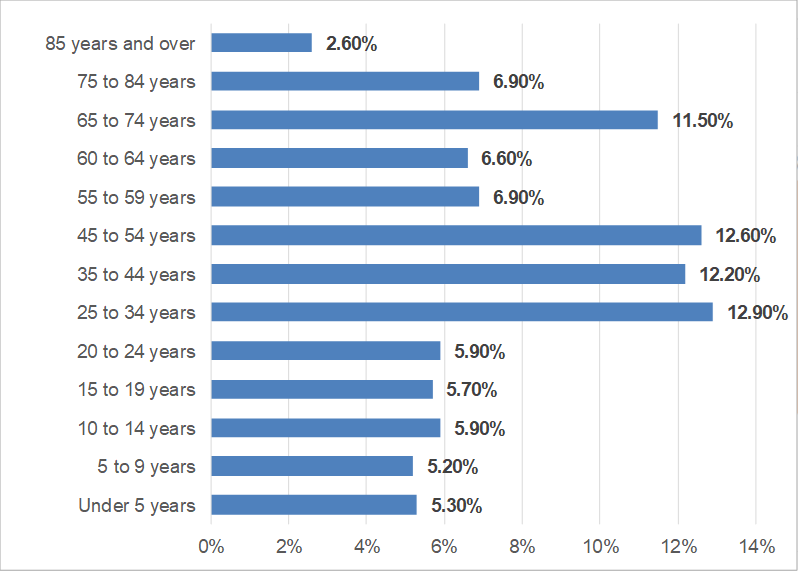
In addition to the rapid population growth, robust and rising demand in the Florida residential market is fueled and by the rapidly rising income, which allows increased household formation.
According to the U.S Census Bureau, the per capita income in Florida in 2019 was $32,887 while the median household income was $59,227. Furthermore, 59% of the state’s households had an income in excess of $50,000. Over the period 2010-2019, total personal income and wages/salaries in Florida registered a cumulative increase of 64.9% and 55.2%, respectively, exceeding the respective national rates of 53.9% and 49%.
The robust and rising demand for housing in the Florida residential market is underscored by the significant reduction of the state’s rental housing vacancy rate from 15.2% in the fourth quarter of 2011 to 6.9% in the fourth quarter of 2020.
The Florida housing market combines competitive income returns with strong capital gains allowing investors to achieve double-digit investment returns
The Florida housing market provides competitive income returns to investors as evidenced in the latest CBRE 2020 cap rate survey. According to this survey, infill multifamily cap rates for stabilized Class A properties in major Florida metropolitan housing markets, such as Miami, Orlando and Tampa ranged between 4.25% to 5.25% in the third quarter of 2020. Since multifamily properties compete in the rental housing market with single-family houses, these cap rates are also indicative of the cap rates and income returns that are achievable in the single-family rental housing market in Florida.
As indicated earlier, besides the competitive income returns, the Florida residential market offers strong capital returns, which are the result of the fast-rising house prices. According to the Federal Housing Finance Agency (FHFA) House Price Index, house prices in the Florida residential market have been rising consistently since 2012 at rates ranging from 6.5% to 12.6% (see Figure 6). The FHFA house price index measures changes in prices for the same house quality in order to capture changes in prices that are solely attributable to market forces. As such, it is a better measure of changes in market prices than median prices.
Figure 6 House price increases in the Florida residential market: 2012-2020
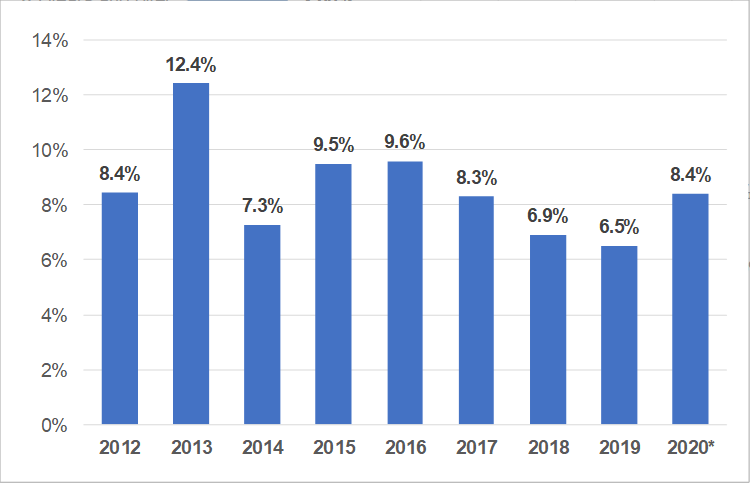
Over the last five years, median sales prices of single-family houses in Florida followed the same strong rising trend depicted by the FHFA House Price Index. According to the Florida Association of Realtors, the annual median sales price for single-family houses increased from $196,000 in 2015 to 290,000 in 2020, representing a 48% cumulative increase. As indicated in Figure 7, median sales prices have been rising at annual rates ranging between 3.9% to 12.2% over that period.
Figure 7 Changes in the median sales price of single-family houses in Florida: 2015-2020
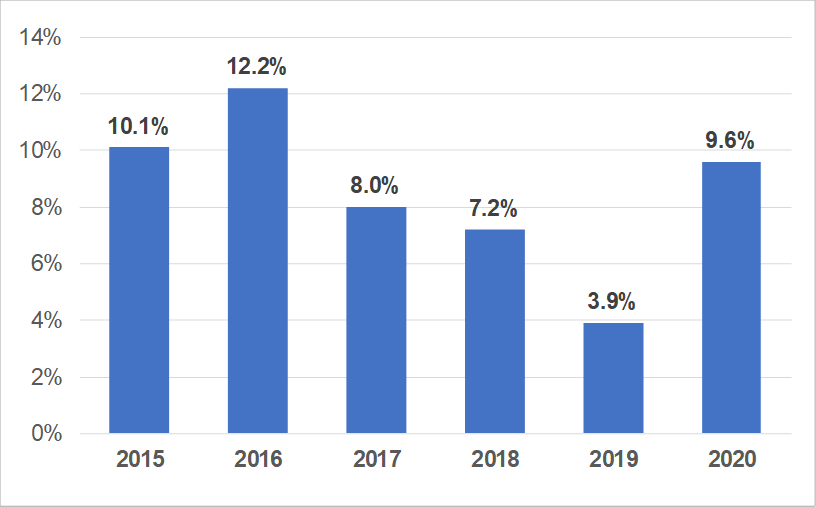
Very large transaction activity provides exceptional liquidity and investment exit, as well as easy investment entry and diverse residential investment opportunities
With Florida being the third largest state in terms of population, residential transaction activity is among the highest in the country. According to the Florida Association of Realtors, a total of 310,378 single-family homes were sold in 2020 in the state of Florida, representing a 5.8% increase compared to 2019. In terms of dollar volume, residential transaction activity in 2020 amounted to $124.6 billion, representing a 22.5% increase compared to the previous year. This large transaction activity provides investors with not only exceptional liquidity and easy investment exit, but also easy market entry with many diverse residential investment opportunities in terms of price ranges and locations.
According to the Florida Association of Realtors, single-family home sales have increased by 16.6% since 2015, underscoring the robust and rising housing demand in the Florida residential market.
In 2020, the average number of days in the market of listed homes until the sale was 75 days compared to 84 in the previous year and, on average, houses were sold at 97.7% of the original price listed.
Conclusion
As it has been shown in this article, the state of Florida combines key investment advantages that make it a unique choice when it comes to residential investments. First of all, it is among the top five states in terms of long-term house price growth and capital gains. Furthermore, it is by the far the largest among these five states, offering a multiplicity of investment opportunities in a considerably greater number of large metropolitan housing markets. These markets provide key investment advantages, including very high liquidity and easy investment exit, as well as many diverse investment opportunities and easy investment entry. In addition to strong capital gains, the Florida residential market offers competitive income returns, which can allow investors to achieve double-digit returns. Finally, Florida’s large, diverse and fast-growing economy, coupled with the fast-rising population and income, supports a robust and rising housing demand in the long term, thereby reducing long-term investment risk in the state’s residential market. For all these reasons, the Florida residential market is a brilliant choice for real estate investments.






